Friends of Myles Standish State Forest
East Head Reservoir Eco Tour

Pitch Pine (Pinus rigida)
In nature, nothing is perfect and everything is perfect.
Trees can be contorted, bent in weird ways, and they’re still beautiful.- Alice Walker
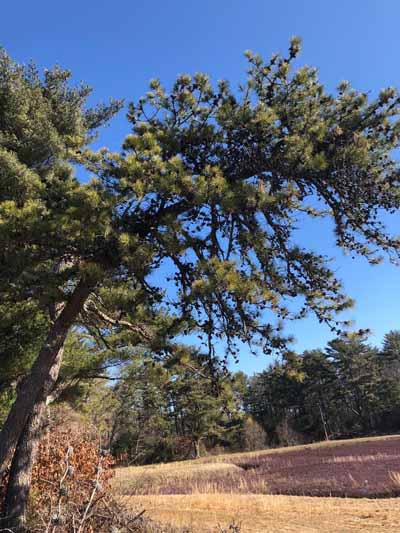
Scraggly Pine
The pitch pine is 30-60 feet in height with a 15-25 foot spread. It can grow in a wide variety of soils and conditions but tolerates shade poorly. Pitch pines are poor self-pruners, keeping living and dead branches for years, making its shape irregular and contorted. Thus, pitch pines are easily identified by the scraggy offshoots of branches and an untidy crown.The common name, pitch pine, comes from early colonists use of this tree to produce turpentine and pitch for sailing vessels. The scientific name Pinus rigida, leads to no end of mirth among the more juvenile of us who forget that it is a long i in Pinus. While the genus name, Pinus, simply means means a pine tree, the species name,rigida, is derived from two sources. The first is because the pitch pine cones have rigid scales, and the second is because the pitch pine needles are also rigid, Both the cones and the needles are good ways to identify pitch pines.
How to Identify A Pitch Pine
Needles in Bunches of Three Look for stout, rigid needles in bundles of three. They are yellowish to dark green and slightly twisted, two to five inches long, with a pointed end.

Pitch Pine Needles in Bundles of Three
Small Round Cones Besides the needles, the pine cones are also distinctive and they have sharp prickles at the end of each scale. They are much smaller and rounder than the long white pine cones (see image below).
Pitch Pine Cone

White Pine Cone (draft image)
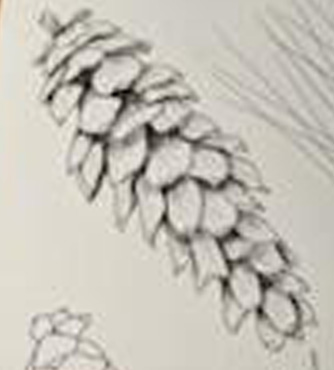
Thick Bark Scales Note the distinctive pattern on the bark. Again, these are very different from the white pine bark on the right below.
Pitch Pine Bark

White Pine Bark
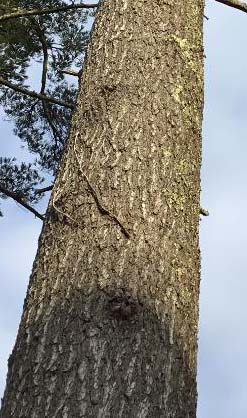
Pitch Pines Lie About Their Age
While most pitch pines live to be about 100 years, the oldest pitch pine had 450 growth rings! Caution, tree huggers! If a pitch pine is stressed, let’s say because of drought, it will form false growth rings. Counting growth rings may make the tree seem older than it is.
Fire Adapted
A unique feature of the pitch pine is its ability to resprout after fires. It is fire resistant with relatively thick and flaky bark. It also generates sprouts from the rootstem, after fire has killed the upper portions of a young tree. Pine needles sometimes grow directly through the trunk, which is another adaptation for fast re-growth after a fire. Finally, pitch pines also form cones with a thick coating of resinous pitch, called “serotinous cones”. These hang on the tree for years waiting for a fire which will melt the resin and allow the cone to open. The cascade of seeds lasts for several months through the winter, as the cone opens from the top down. The new seeds want open soil, and will get a start under a scrub oak, which is also fire resistant.
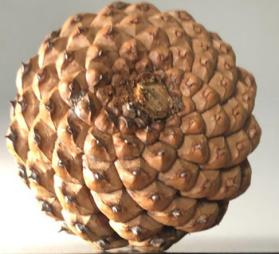
Fractal Base of a Pitch Pine Cone - Charlie Pye
Anthropogenic landscaping
For the last ten thousand years or so humans have been setting fires around here. They found that by burning every six or so years they could keep the understory clear for ease of travel and for better sightlines while hunting. As a result, pitch pines become the only tall tree left on the landscape, as the others such as the white pines, and most deciduous trees are killed by fire. So, in fire prone areas the pitch pines come to dominate the landscape. They become the only tall tree. And even then, with frequent fires the pitch pines may only cover as little as ten percent canopy cover, which is the lower limit to be considered a forest.
A Minimum Forest: Least Dense

A Landscape Created by Humans
Pollin
All pines, are wind pollinated. The male cones are produced on the lower half of the tree while female cones are produced at the top of the tree. This reduces the chance of self pollination. In the spring the male cones produce millions of lightweight seeds that drift on the wind, fertilizing female cones. This pollen may become so thick it looks like yellow smoke and may coat nearby surfaces. The pine pollen is about 80 micrometers long (.003 inches) and has two air sacs to add buoyancy which gives these pollen grains mickey mouse ears. Pollen has been found up to 40 miles away from parent pitch pines.
Up close, pine tree pollen resembles Mickey Mouse ears.
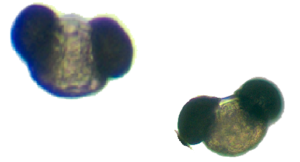
(Photo by Andy McCubbin, WSU plant pathologist)
Uses
The wood of pitch pine is so laden with pitch that it resists decay. Traditional and historic uses of pitch pines were lumber, railroad cross-ties, water wheels, fuel-wood, posts, resin products (naval stores), mixed pulp, charcoal, canoe building, and pine knot torches. Shorter needled trees have been used as Christmas trees.
Pine Knots

Irina Kadis salicicola.com
As Medicine
Historic medicinal uses of the tree were for internal consumption of resins to treat rheumatism and constipation, and for external use applied to burns, cuts, and boils. The resin-rich heartwood and branch knots were burned and the smoke used as an insecticide. Forest Community
Red squirrels feed heavily on the cone’s seeds. In areas of high red squirrel populations, the pitch pine will produce fewer seeds some years (bust) and a great many seeds in other years (boon or mast year). While this boom and bust cycle serves to reduce squirrel numbers during the lean years/ The trees then produce a huge number of seeds, more than the remaining squirrels can eat. But the squirrels, somehow, can sense an upcoming boom year and will have multiple sets of young.
The seeds are also preferred by birds such as quail, chickadees and juncos, as well as mice.
Saving the Fire Dependent Pitch Pine : Controlled Burns
As Thoreau said.
"To my surprise I find that in the pretty dense pitch pine woods, where there are only several white pine old enough to bear, yet there are countless white pine springing up under the pitch pine (as well as the oak) and very few or scarcely any pitch pines and they are sickly."
(source: The Writings of Henry David Thoreau .... - Volume 20 - Page 162)
As we saw earlier, pitch pines are fire adapted, but they are also fire dependant. Pitch pines grow in the sun, without fire they become shaded by larger trees, where they struggle to survive. The bad news is that the suppression of fire during the last 150 years or so has shrunk the pitch pine habitats. Without remediation, pitch pines will slowly be relegated to an occasional refuge, and the rich suite of life dependent on the pine barrens will also wither away.
To preserve this habitat, prescribed burns are being done in parts of the Myles Standish State Forest to restore a least dense pitch pine forest, and to restore habitat for so many beautiful creatures.
All line drawings by: Patricia J. Cassidy